Effects of Fine Particulate Matter (PM2.5) on Systemic Oxidative Stress and Cardiac Function in ApoE−/− Mice
Abstract
:1. Introduction
New and Noteworthy
2. Materials and Methods
2.1. Animals
2.2. PM2.5 Sampling
2.3. Elemental and Ionic Analysis in Fine Particles
2.4. PM2.5 Exposure
2.5. Electrocardiograph (ECG) Monitoring and Heart Rate Variability (HRV) Assessment
2.6. Echocardiography and Hemodynamic Measurements
2.7. Biochemical Analysis of Serum
2.8. Reverse Transcriptase Polymerase Chain Reaction (RT-PCR)
2.9. Western Blot
3. Statistical Analysis
4. Results
4.1. Elemental and Ionic Contents of Fine Particles
4.2. Heart Rate (HR) and HRV Indices Analyses
4.3. Electrocardiogram (ECG) Type Changes
4.4. Echocardiography Changes
4.5. Measurement of Oxidants and Antioxidants in the Plasma
4.6. mRNA Expressions of p22phox and p47phox in Myocardium
4.7. Protein Expression of p22phox and p47phox in Myocardium
4.8. Pathological Characters of Heart Tissue and Vessel Tissue
5. Discussion
6. Conclusions
Acknowledgments
Author Contributions
Conflicts of Interest
Abbreviations
| ApoE-/- | apolipoprotein E knock out |
| ECG | electrocardiogram |
| Echo | echocardiogram |
| HF | high frequency |
| HRV | heart rate variability |
| LBBB | left bundle-branch block |
| LF | low frequency |
| LV | left ventricle |
| LVEDd | left ventricular end diastolic dimension |
| LVESd | left ventricular end-systolic dimension |
| LVEF | left ventricular ejection fraction |
| LVFS | left ventricular fractional shortening |
| LVPWd | left ventricular end-diastolic posterior wall thickness |
| LVAWd | left ventricular end diastolic anterior wall thickness |
| MDA | malondialdehyde |
| NADPH | nicotinamide adenine dinucleotide 2′-phosphate |
| p22phox | nadph subunit 22-kilodalton |
| p47phox | nadph subunit 47-kilodalton |
| PM2.5 | fine particulate matters |
| SOD | superoxide dismutase |
References
- Effect of Air Pollution on Health: Report of the Committee on Public Health Relations of the New York Academy of Medicine. Bull. N. Y. Acad. Med. 1931, 7, 751–775.
- Bauer, M.; Moebus, S.; Mohlenkamp, S.; Dragano, N.; Nonnemacher, M.; Fuchsluger, M.; Kessler, C.; Jakobs, H.; Memmesheimer, M.; Erbel, R.; et al. Urban particulate matter air pollution is associated with subclinical atherosclerosis: Results from the HNR (Heinz Nixdorf Recall) study. J. Am. Coll. Cardiol. 2010, 56, 1803–1808. [Google Scholar] [CrossRef] [PubMed]
- Hoffmann, B.; Moebus, S.; Kroger, K.; Stang, A.; Mohlenkamp, S.; Dragano, N.; Schmermund, A.; Memmesheimer, M.; Erbel, R.; Jockel, K.H. Residential exposure to urban air pollution, ankle-brachial index, and peripheral arterial disease. Epidemiology 2009, 20, 280–288. [Google Scholar] [CrossRef] [PubMed]
- Hoffmann, B.; Moebus, S.; Mohlenkamp, S.; Stang, A.; Lehmann, N.; Dragano, N.; Schmermund, A.; Memmesheimer, M.; Mann, K.; Erbel, R.; et al. Residential exposure to traffic is associated with coronary atherosclerosis. Circulation 2007, 116, 489–496. [Google Scholar] [CrossRef] [PubMed]
- Allen, R.W.; Criqui, M.H.; Diez, R.A.; Allison, M.; Shea, S.; Detrano, R.; Sheppard, L.; Wong, N.D.; Stukovsky, K.H.; Kaufman, J.D. Fine particulate matter air pollution, proximity to traffic, and aortic atherosclerosis. Epidemiology 2009, 20, 254–264. [Google Scholar] [CrossRef] [PubMed]
- Chen, T.; Jia, G.; Wei, Y.; Li, J. Beijing ambient particle exposure accelerates atherosclerosis in ApoE knockout mice. Toxicol. Lett. 2013, 223, 146–153. [Google Scholar] [CrossRef] [PubMed]
- Sun, Q.; Hong, X.; Wold, L.E. Cardiovascular effects of ambient particulate air pollution exposure. Circulation 2010, 121, 2755–2765. [Google Scholar] [CrossRef] [PubMed]
- Lu, P.; Fang, B.; Jiang, R.; Song, W. Th17 related inflammatory effects of intratracheally instilled fine particular matter in ApoE−/− mice. Fresenius Environ. Bull. 2015, 11, 3984–3995. [Google Scholar]
- Guanghe Wang, R.J.; Zhao, Z. Effects of ozone and fine particulate matter (PM2.5) on rat cardiac autonomic nervous system and systemic inflammation. Toxicol. Lett. 2013, 217, 23–33. [Google Scholar] [CrossRef] [PubMed]
- Ma, X.; Zhang, H.J.; Whiteis, C.A.; Tian, X.; Davisson, R.L.; Kregel, K.C.; Abboud, F.M.; Chapleau, M.W. NAD(P)H oxidase-induced oxidative stress in sympathetic ganglia of apolipoprotein E deficient mice. Auton. Neurosci. 2006, 126–127, 285–291. [Google Scholar] [CrossRef] [PubMed]
- Whitman, S.C. A practical approach to using mice in atherosclerosis research. Clin. Biochem. Rev. 2004, 25, 81–93. [Google Scholar] [PubMed]
- Thomson, E.; Kumarathasan, P.; Goegan, P.; Aubin, R.A.; Vincent, R. Differential regulation of the lung endothelin system by urban particulate matter and ozone. Toxicol. Sci. 2005, 88, 103–113. [Google Scholar] [CrossRef] [PubMed]
- Heart rate variability: Standards of measurement, physiological interpretation and clinical use. Task force of the European Society of Cardiology and the North American Society of Pacing and Electrophysiology. Circulation 1996, 93, 1043–1065.
- Stein, P.K.; Kleiger, R.E. Insights from the study of heart rate variability. Annu. Rev. Med. 1999, 50, 249–261. [Google Scholar] [CrossRef] [PubMed]
- Weichenthal, S. Selected physiological effects of ultrafine particles in acute cardiovascular morbidity. Environ. Res. 2012, 115, 26–36. [Google Scholar] [CrossRef] [PubMed]
- Godleski, J.J.; Verrier, R.L.; Koutrakis, P.; Catalano, P.; Coull, B.; Reinisch, U.; Lovett, E.G.; Lawrence, J.; Murthy, G.G.; Wolfson, J.M.; et al. Mechanisms of morbidity and mortality from exposure to ambient air particles. Res. Rep. Health Eff. Inst. 2000, 91, 5–88; discussion 89–103. [Google Scholar] [PubMed]
- Ibald-Mulli, A.; Timonen, K.L.; Peters, A.; Heinrich, J.; Wolke, G.; Lanki, T.; Buzorius, G.; Kreyling, W.G.; de Hartog, J.; Hoek, G.; et al. Effects of particulate air pollution on blood pressure and heart rate in subjects with cardiovascular disease: A multicenter approach. Environ. Health Perspect. 2004, 112, 369–377. [Google Scholar] [CrossRef] [PubMed]
- Timonen, K.L.; Vanninen, E.; de Hartog, J.; Ibald-Mulli, A.; Brunekreef, B.; Gold, D.R.; Heinrich, J.; Hoek, G.; Lanki, T.; Peters, A.; et al. Effects of ultrafine and fine particulate and gaseous air pollution on cardiac autonomic control in subjects with coronary artery disease: The ULTRA study. J. Expo. Sci. Environ. Epidemiol. 2006, 16, 332–341. [Google Scholar] [CrossRef] [PubMed]
- Devlin, R.B.; Ghio, A.J.; Kehrl, H.; Sanders, G.; Cascio, W. Elderly humans exposed to concentrated air pollution particles have decreased heart rate variability. Eur. Respir. J. Suppl. 2003, 40, 76s–80s. [Google Scholar] [CrossRef] [PubMed]
- Schwartz, J.; Litonjua, A.; Suh, H.; Verrier, M.; Zanobetti, A.; Syring, M.; Nearing, B.; Verrier, R.; Stone, P.; MacCallum, G.; et al. Traffic related pollution and heart rate variability in a panel of elderly subjects. Thorax 2005, 60, 455–461. [Google Scholar] [CrossRef] [PubMed]
- Routledge, H.C.; Manney, S.; Harrison, R.M.; Ayres, J.G.; Townend, J.N. Effect of inhaled sulphur dioxide and carbon particles on heart rate variability and markers of inflammation and coagulation in human subjects. Heart 2006, 92, 220–227. [Google Scholar] [CrossRef] [PubMed]
- Corey, L.M.; Baker, C.; Luchtel, D.L. Heart-rate variability in the apolipoprotein E knockout transgenic mouse following exposure to Seattle particulate matter. J. Toxicol. Environ. Health A 2006, 69, 953–965. [Google Scholar] [CrossRef] [PubMed]
- Min, K.B.; Min, J.Y.; Cho, S.I.; Paek, D. The relationship between air pollutants and heart-rate variability among community residents in Korea. Inhal. Toxicol. 2008, 20, 435–444. [Google Scholar] [CrossRef] [PubMed]
- Bussink, B.E.; Holst, A.G.; Jespersen, L.; Deckers, J.W.; Jensen, G.B.; Prescott, E. Right bundle branch block: Prevalence, risk factors, and outcome in the general population: Results from the Copenhagen City Heart Study. Eur. Heart J. 2013, 34, 138–146. [Google Scholar] [CrossRef] [PubMed]
- Geiter, H.B. E-Z ECG Rhythm Interpretation; Davis Company: Philidelphia, PA, USA, 2007; p. 517. [Google Scholar]
- Pekkanen, J.; Peters, A.; Hoek, G.; Tiittanen, P.; Brunekreef, B.; de Hartog, J.; Heinrich, J.; Ibald-Mulli, A.; Kreyling, W.G.; Lanki, T.; et al. Particulate air pollution and risk of ST-segment depression during repeated submaximal exercise tests among subjects with coronary heart disease: The Exposure and Risk Assessment for Fine and Ultrafine Particles in Ambient Air (ULTRA) study. Circulation 2002, 106, 933–938. [Google Scholar] [CrossRef] [PubMed]
- Chuang, K.J.; Coull, B.A.; Zanobetti, A.; Suh, H.; Schwartz, J.; Stone, P.H.; Litonjua, A.; Speizer, F.E.; Gold, D.R. Particulate air pollution as a risk factor for ST-segment depression in patients with coronary artery disease. Circulation 2008, 118, 1314–1320. [Google Scholar] [CrossRef] [PubMed]
- Weldy, C.S.; Liu, Y.; Liggitt, H.D.; Chin, M.T. In utero exposure to diesel exhaust air pollution promotes adverse intrauterine conditions, resulting in weight gain, altered blood pressure, and increased susceptibility to heart failure in adult mice. PLoS ONE 2014, 9, e88582. [Google Scholar] [CrossRef] [PubMed]
- Gorr, M.W.; Velten, M.; Nelin, T.D.; Youtz, D.J.; Sun, Q.; Wold, L.E. Early life exposure to air pollution induces adult cardiac dysfunction. Am. J. Physiol. Heart Circ. Physiol. 2014, 307, H1353–H1360. [Google Scholar] [CrossRef] [PubMed]
- Osornio-Vargas, A.R.; Bonner, J.C.; Alfaro-Moreno, E.; Martinez, L.; Garcia-Cuellar, C.; Ponce-de-Leon, R.S.; Miranda, J.; Rosas, I. Proinflammatory and cytotoxic effects of Mexico City air pollution particulate matter in vitro are dependent on particle size and composition. Environ. Health Perspect. 2003, 111, 1289–1293. [Google Scholar] [CrossRef] [PubMed]
- Gutierrez-Castillo, M.E.; Roubicek, D.A.; Cebrian-Garcia, M.E.; De Vizcaya-Ruiz, A.; Sordo-Cedeno, M.; Ostrosky-Wegman, P. Effect of chemical composition on the induction of DNA damage by urban airborne particulate matter. Environ. Mol. Mutagen 2006, 47, 199–211. [Google Scholar] [CrossRef] [PubMed]
- Andersson, H.; Piras, E.; Demma, J.; Hellman, B.; Brittebo, E. Low levels of the air pollutant 1-nitropyrene induce DNA damage, increased levels of reactive oxygen species and endoplasmic reticulum stress in human endothelial cells. Toxicology 2009, 262, 57–64. [Google Scholar] [CrossRef] [PubMed]
- Park, J.H.; Troxel, A.B.; Harvey, R.G.; Penning, T.M. Polycyclic aromatic hydrocarbon (PAH) o-quinones produced by the aldo-keto-reductases (AKRs) generate abasic sites, oxidized pyrimidines, and 8-oxo-dGuo via reactive oxygen species. Chem. Res. Toxicol. 2006, 19, 719–728. [Google Scholar] [CrossRef] [PubMed]
- Nong, Q.; Komatsu, M.; Izumo, K.; Indo, H.P.; Xu, B.; Aoyama, K.; Majima, H.J.; Horiuchi, M.; Morimoto, K.; Takeuchi, T. Involvement of reactive oxygen species in Microcystin-LR-induced cytogenotoxicity. Free Radic. Res. 2007, 41, 1326–1337. [Google Scholar] [CrossRef] [PubMed]
- Amara, N.; Bachoual, R.; Desmard, M.; Golda, S.; Guichard, C.; Lanone, S.; Aubier, M.; Ogier-Denis, E.; Boczkowski, J. Diesel exhaust particles induce matrix metalloprotease-1 in human lung epithelial cells via a NADP(H) oxidase/NOX4 redox-dependent mechanism. Am. J. Physiol. Lung Cell Mol. Physiol. 2007, 293, L170–L181. [Google Scholar] [CrossRef] [PubMed]
- Brook, R.D.; Franklin, B.; Cascio, W.; Hong, Y.; Howard, G.; Lipsett, M.; Luepker, R.; Mittleman, M.; Samet, J.; Smith, S.J.; et al. Air pollution and cardiovascular disease: A statement for healthcare professionals from the Expert Panel on Population and Prevention Science of the American Heart Association. Circulation 2004, 109, 2655–2671. [Google Scholar] [CrossRef] [PubMed]
- Wan, Q.; Cui, X.; Shao, J.; Zhou, F.; Jia, Y.; Sun, X.; Zhao, X.; Chen, Y.; Diao, J.; Zhang, L. Beijing ambient particle exposure accelerates atherosclerosis in ApoE knockout mice by upregulating visfatin expression. Cell Stress Chaperones 2014, 19, 715–724. [Google Scholar] [CrossRef] [PubMed]
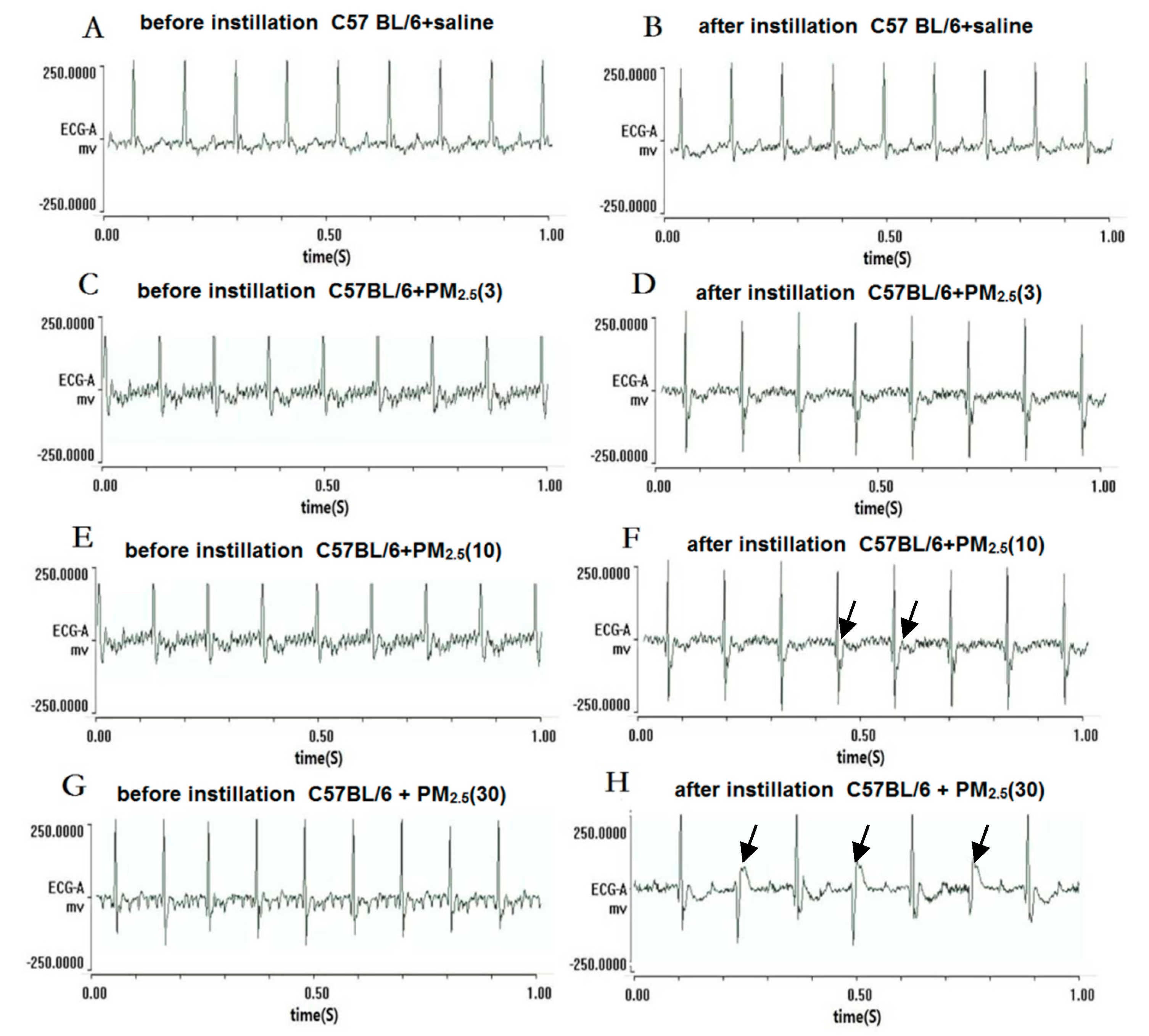

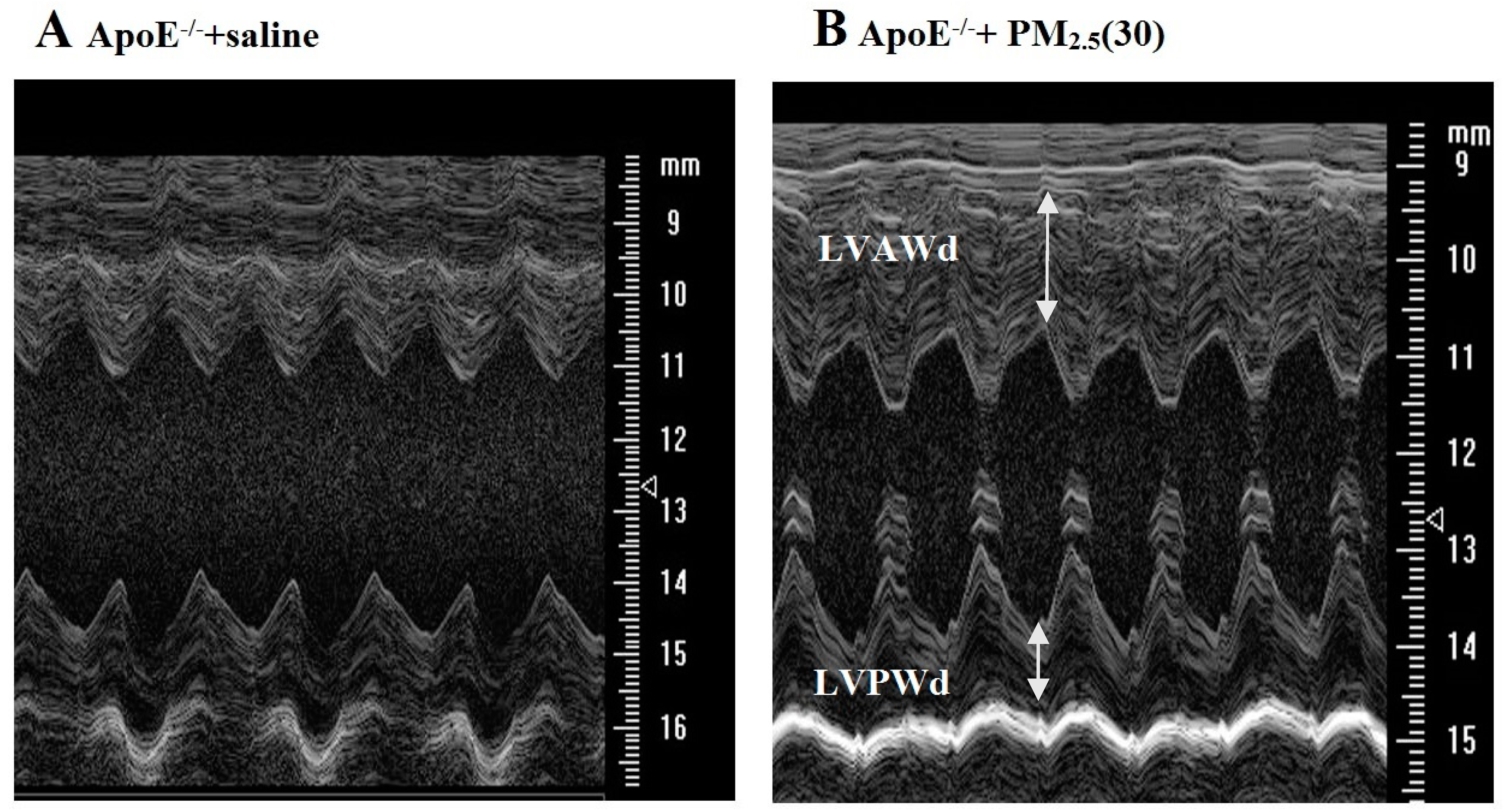
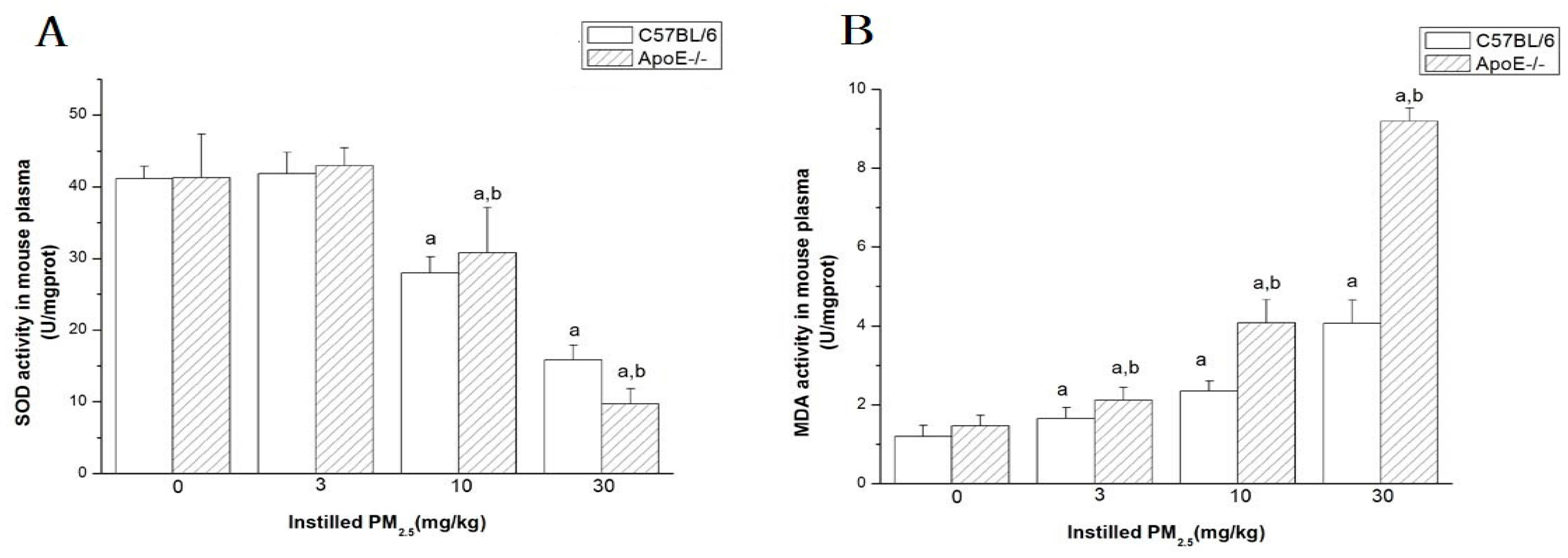



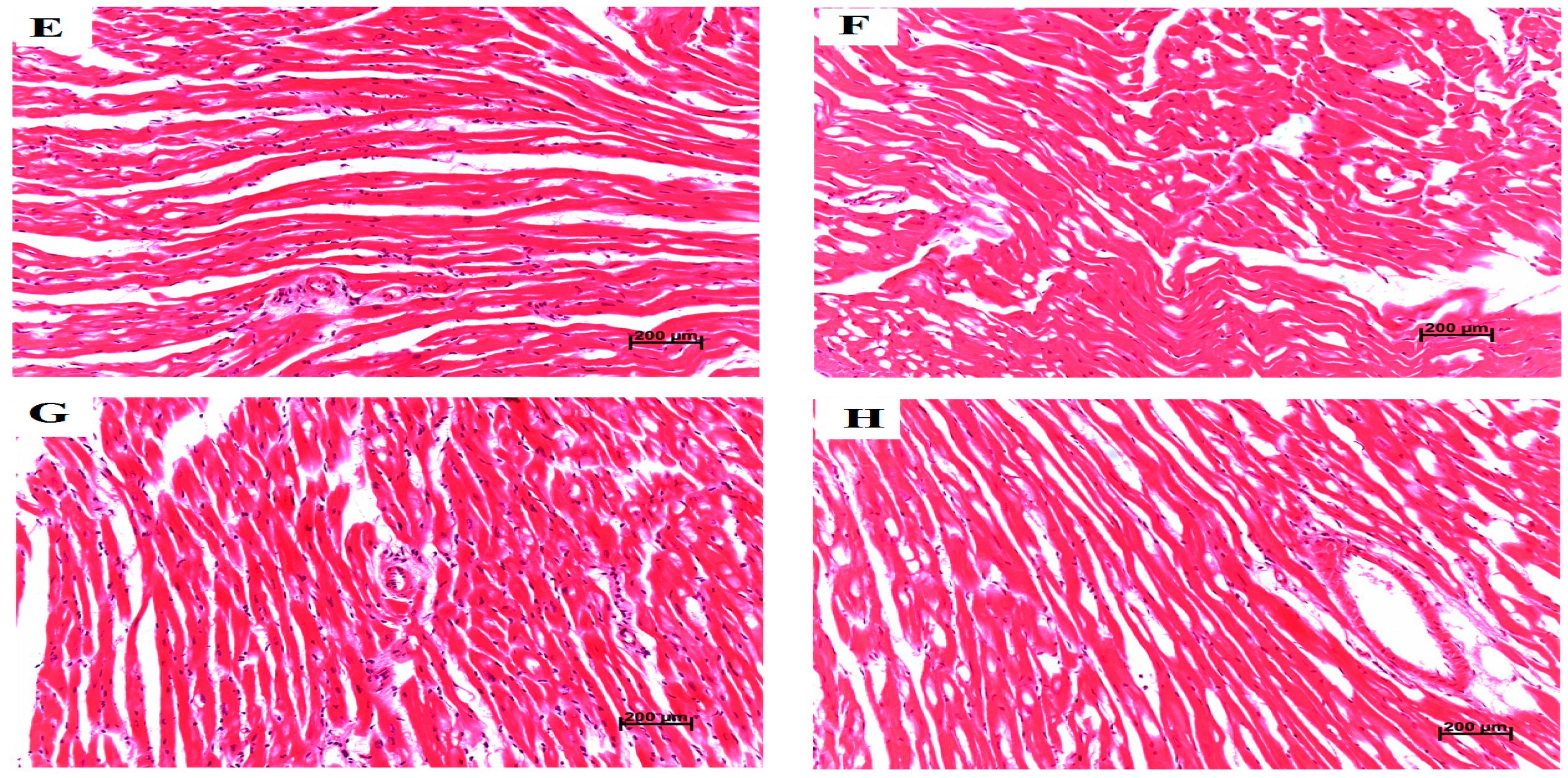
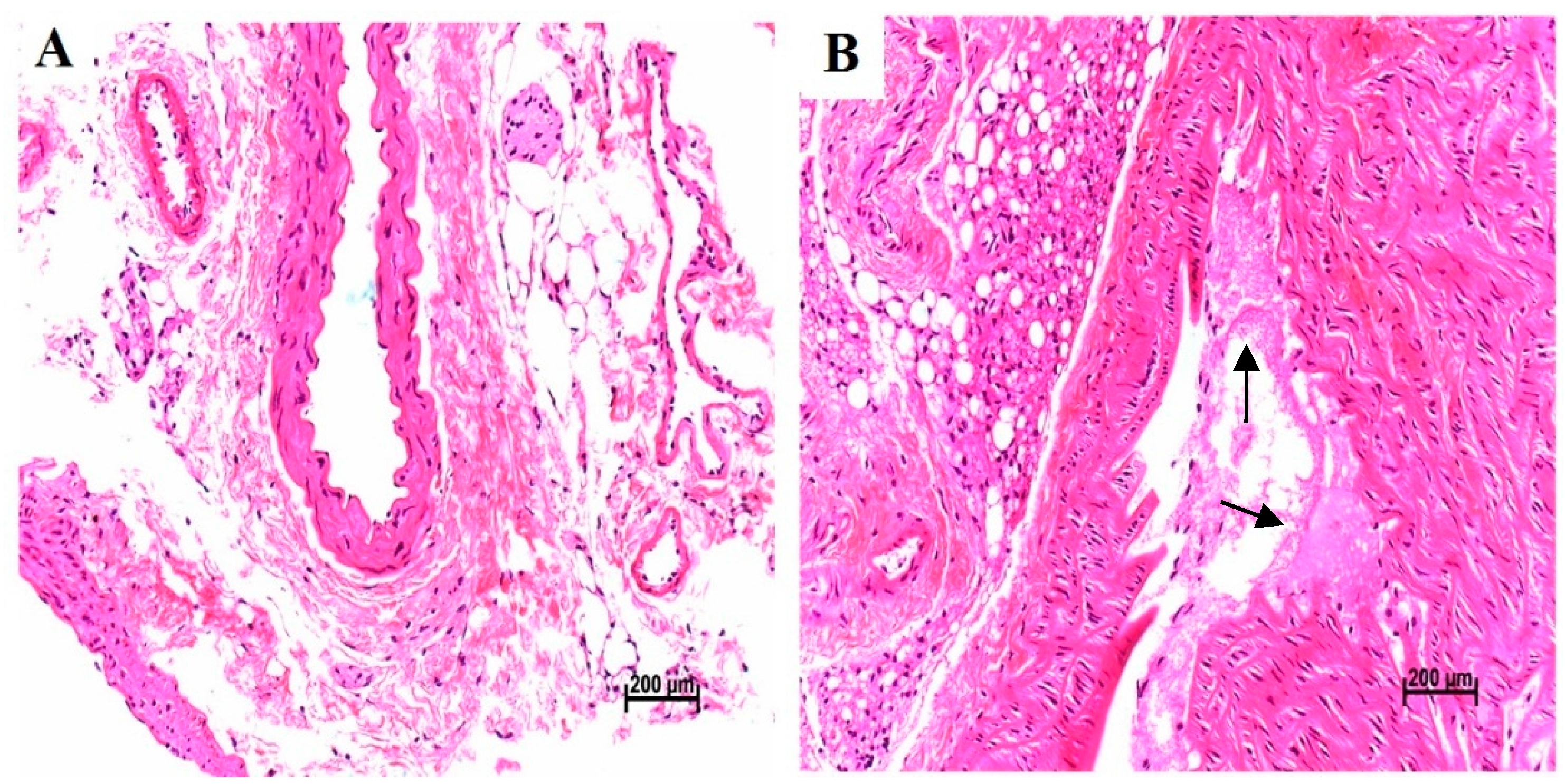
| Genes | Primer Pairs |
|---|---|
| p22phox-m-F | CATCGTGGCTACTGCTGGAC |
| p22phox-m-R | TGGACCCCTTTTTCCTCTTT |
| p47phox-m-F | CGAAGAAGCCTGAGACATACC |
| p47phox-m-R | ATATCCCCTTTCCTCACCACC |
| GADPH-m-F | ACCACAGTCCATGCCATCAC |
| GADPH-m-R | TCCACCACCCTGTTGCTGTA |
| Elements | Concentration (%) | Elements | Concentration (%) | Elements | Concentration (%) |
|---|---|---|---|---|---|
| Ca | 21.6 | Ba | 0.4 | SO42− | 40.6 |
| Fe | 21.5 | Cu | 0.4 | NH4+ | 27.1 |
| K | 21.1 | As | 0.3 | NO3− | 18.9 |
| Na | 14.9 | Sr | 0.1 | Cl− | 9.2 |
| Al | 6.3 | Ti | 0.1 | Na+ | 2.2 |
| Zn | 5.3 | V | 0.1 | K+ | 1.8 |
| Mg | 4.3 | Cr | 0.1 | C2O42− | 0.8 |
| Pb | 2.1 | Ni | 0.05 | F− | 0.1 |
| Mn | 1.2 |
| Groups | HR (bmp) | TV | LF (ms2) | HF (ms2) | LF/HF |
|---|---|---|---|---|---|
| Before instillation | |||||
| C57BL/6 + saline | 516 ± 25 | 5.82 ± 3.66 | 2.45 ± 1.11 | 1.87 ± 0.97 | 1.4 ± 0.37 |
| C57 BL/6 + PM2.5 (3) | 533 ± 31 | 4.73 ± 2.48 | 2.29 ± 0.32 | 2.08 ± 0.45 | 1.16 ± 0.40 |
| C57BL/6 + PM2.5 (10) | 505 ± 25 | 5.77 ± 2.76 | 2.7 ± 1.40 | 2.07 ± 1.00 | 1.52 ± 0.82 |
| C57 BL/6 + PM2.5 (30) | 504 ± 19 | 5.05 ± 1.97 | 2.92 ± 0.94 | 2.34 ± 1.06 | 1.32 ± 0.32 |
| After instillation | |||||
| C57 BL/6 + saline | 508 ± 23 | 5.61 ± 2.05 | 2.61 ± 0.90 | 1.87 ± 0.75 | 1.44 ± 0.36 |
| C57BL/6 + PM2.5 (3) | 494 ± 34 b | 3.93 ± 1.78 b | 2.02 ± 0.42 | 2.15 ± 0.35 | 0.93 ± 0.07 a |
| C57BL/6 + PM2.5 (10) | 475 ± 49 b | 3.24 ± 1.82 a | 1.68 ± 0.97 a,b | 3.05 ± 1.16 a | 0.53 ± 0.27 a |
| C57BL/6 + PM2.5 (30) | 435 ± 45 a,b | 1.47 ± 1.09 a,b | 1.63 ± 0.68 a,b | 3.56 ± 1.11 a,b | 0.45 ± 0.12 a,b |
| Before instillation | |||||
| ApoE−/− + saline | 533 ± 27 | 5.33 ± 0.38 | 1.14 ± 0.09 | 2.44 ± 0.18 | 0.52 ± 0.02 |
| ApoE−/− + PM2.5 (3) | 549 ± 35 | 5.9 ± 0.62 | 1.03 ± 0.02 | 2.75 ± 0.35 | 0.45 ± 0.07 |
| ApoE−/− + PM2.5 (10) | 536 ± 40 | 5.75 ± 0.34 | 0.91 ± 0.39 | 2.47 ± 0.75 | 0.42 ± 0.06 |
| ApoE−/− + PM2.5 (30) | 524 ± 44 | 5.98 ± 0.71 | 1.37 ± 0.10 | 2.54 ± 0.1 | 0.55 ± 0.02 |
| After instillation | |||||
| ApoE−/− + saline | 530 ± 19 | 5.25 ± 1.05 | 0.97 ± 0.21 | 2.48 ± 0.45 | 0.46 ± 0.13 |
| ApoE−/− + PM2.5 (3) | 536 ± 37 | 2.9 ± 0.42 a,b | 0.86 ± 0.24 c | 2.95 ± 0.28 | 0.54 ± 0.16 c |
| ApoE−/− + PM2.5 (10) | 484 ± 47 | 2.82 ± 0.96 a,b | 0.73 ± 0.23 | 3.25 ± 0.85 | 0.21 ± 0.03 a,c |
| ApoE−/− + PM2.5 (30) | 451 ± 39 a,b | 2.57 ± 0.41 a,b | 0.21 ± 0.04 b,c | 3.94 ± 0.75 b | 0.05 ± 0.01 a,b,c |
| Groups | EF | FS | LVESd | LVEDd | LVPWd | LVAWd |
|---|---|---|---|---|---|---|
| C57BL/6 + saline | 57.21 ± 12.11 | 30.38 ± 8.16 | 3.14 ± 0.73 | 4.46 ± 0.63 | 0.69 ± 0.14 | 0.75 ± 0.12 |
| C57BL/6 + PM2.5 (3) | 54.04 ± 7.06 | 28.12 ± 4.73 | 3.4 ± 0.21 | 4.73 ± 0.30 | 0.62 ± 0.07 | 0.70 ± 0.09 |
| C57 BL/6 + PM2.5 (10) | 53.74 ± 13.40 | 28.19 ± 8.96 | 3.19 ± 0.56 | 4.43 ± 0.31 | 0.64 ± 0.12 | 0.69 ± 0.09 |
| C57 BL/6 + PM2.5 (30) | 50.21 ± 7.32 | 25.49 ± 4.69 | 3.28 ± 0.37 | 4.4 ± 0.24 | 0.57 ± 0.09 | 0.63 ± 0.08 |
| ApoE−/− + saline | 67.69 ± 9.07 | 37.76 ± 7.34 | 2.57 ± 0.45 | 4.1 ± 0.28 | 0.74 ± 0.05 | 0.87 ± 0.18 |
| ApoE−/− + PM2.5 (3) | 72.57 ± 6.93 a,b | 41.49 ± 6.37 a,b | 2.27 ± 0.43 | 3.84 ± 0.38 | 0.70 ± 0.07 | 0.78 ± 0.06 |
| ApoE−/− + PM2.5 (10) | 74.76 ± 8.20 a,b | 43.16 ± 6.75 a,b | 2.52 ± 0.61 | 3.89 ± 0.66 | 0.77 ± 0.07 | 0.84 ± 0.08 |
| ApoE−/− + PM2.5 (30) | 67.67 ± 12.25 | 37.97 ± 9.35 | 2.51 ± 0.75 | 3.98 ± 0.65 | 0.80 ± 0.18 a | 0.96 ± 0.30 a |
© 2016 by the authors; licensee MDPI, Basel, Switzerland. This article is an open access article distributed under the terms and conditions of the Creative Commons Attribution (CC-BY) license (http://creativecommons.org/licenses/by/4.0/).
Share and Cite
Pei, Y.; Jiang, R.; Zou, Y.; Wang, Y.; Zhang, S.; Wang, G.; Zhao, J.; Song, W. Effects of Fine Particulate Matter (PM2.5) on Systemic Oxidative Stress and Cardiac Function in ApoE−/− Mice. Int. J. Environ. Res. Public Health 2016, 13, 484. https://doi.org/10.3390/ijerph13050484
Pei Y, Jiang R, Zou Y, Wang Y, Zhang S, Wang G, Zhao J, Song W. Effects of Fine Particulate Matter (PM2.5) on Systemic Oxidative Stress and Cardiac Function in ApoE−/− Mice. International Journal of Environmental Research and Public Health. 2016; 13(5):484. https://doi.org/10.3390/ijerph13050484
Chicago/Turabian StylePei, Yiling, Rongfang Jiang, Yunzeng Zou, Yu Wang, Suhui Zhang, Guanghe Wang, Jinzhuo Zhao, and Weimin Song. 2016. "Effects of Fine Particulate Matter (PM2.5) on Systemic Oxidative Stress and Cardiac Function in ApoE−/− Mice" International Journal of Environmental Research and Public Health 13, no. 5: 484. https://doi.org/10.3390/ijerph13050484
APA StylePei, Y., Jiang, R., Zou, Y., Wang, Y., Zhang, S., Wang, G., Zhao, J., & Song, W. (2016). Effects of Fine Particulate Matter (PM2.5) on Systemic Oxidative Stress and Cardiac Function in ApoE−/− Mice. International Journal of Environmental Research and Public Health, 13(5), 484. https://doi.org/10.3390/ijerph13050484





